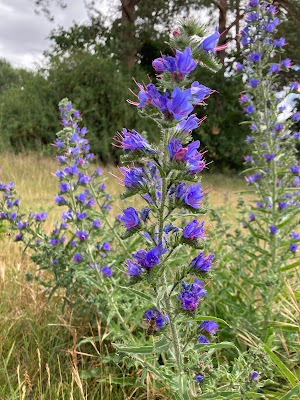We had a light sprinkle of rain in the early hours on Wednesday morning but otherwise still no rain. Thats eight weeks for us here without rain of any substance. Bear in mind too that we had a dry Spring and April showers failed to materialise. It is not officially a drought but in practice it is for us. The heatwave Summer of 2018 was the last time it was this dry. We are feeding the sheep hay and I know of a cattle farmer who is already feeding his herd silage which was intended to see them through the Winter. The lack of grass growth means that feed costs are going to go even higher for livestock farmers. All this will eventually lead to still higher prices for consumers.
I came across another plant that seems to be coping very will with the droughty conditions. This is Lady's Bedstraw (Galium verum) which forms a dense mat of spikey foliage from which frothy yellow flower panicles emerge. Lady's Bedstraw is common in dry, sandy grassland and hedgerows. It can be a bit inconspicuous but at the moment vibrant green patches in sunburnt grass causes it to stand out a bit more than usual.
Its called Lady's Bedstraw as it used to be added to straw-filled mattresses for adding fragrance, particularly for women who were due to give birth. According to Norse mythology it had a sedative effect which helped during labour. Frigg is the Norse goddess of married women and it is also known as Frigg's Grass.
 |
| Lady's Bedstraw (Galium verum) |
 |
| An oasis in the burnt grass |























%20Chrles%20Sharp%20Wiki..jpg)
